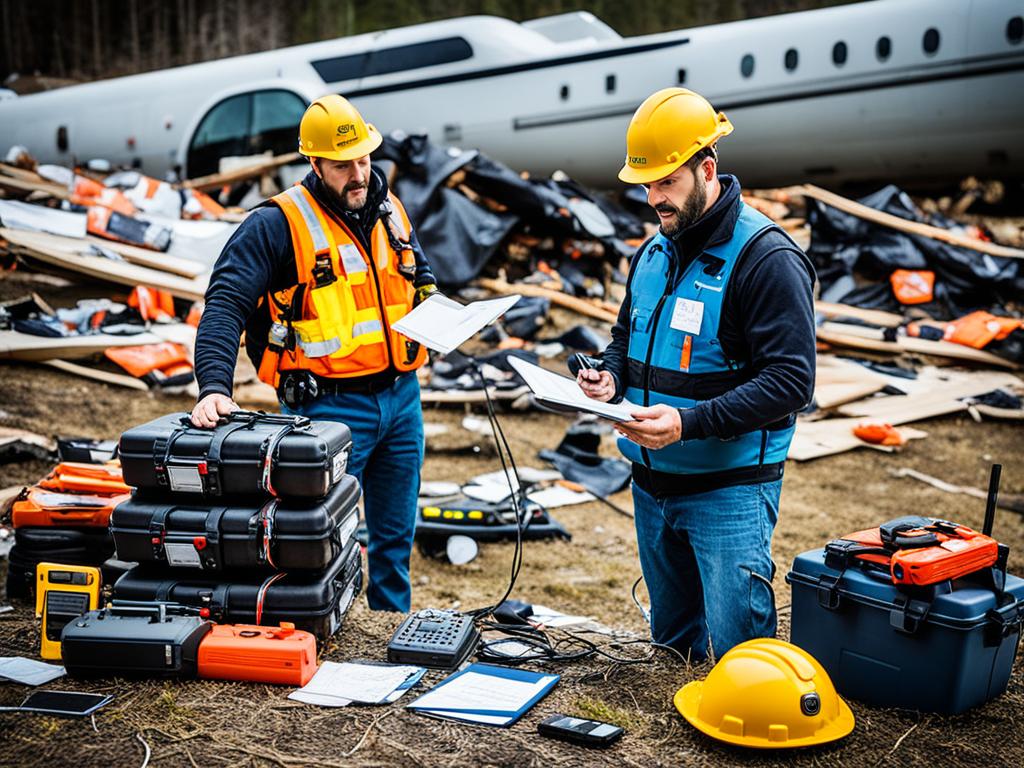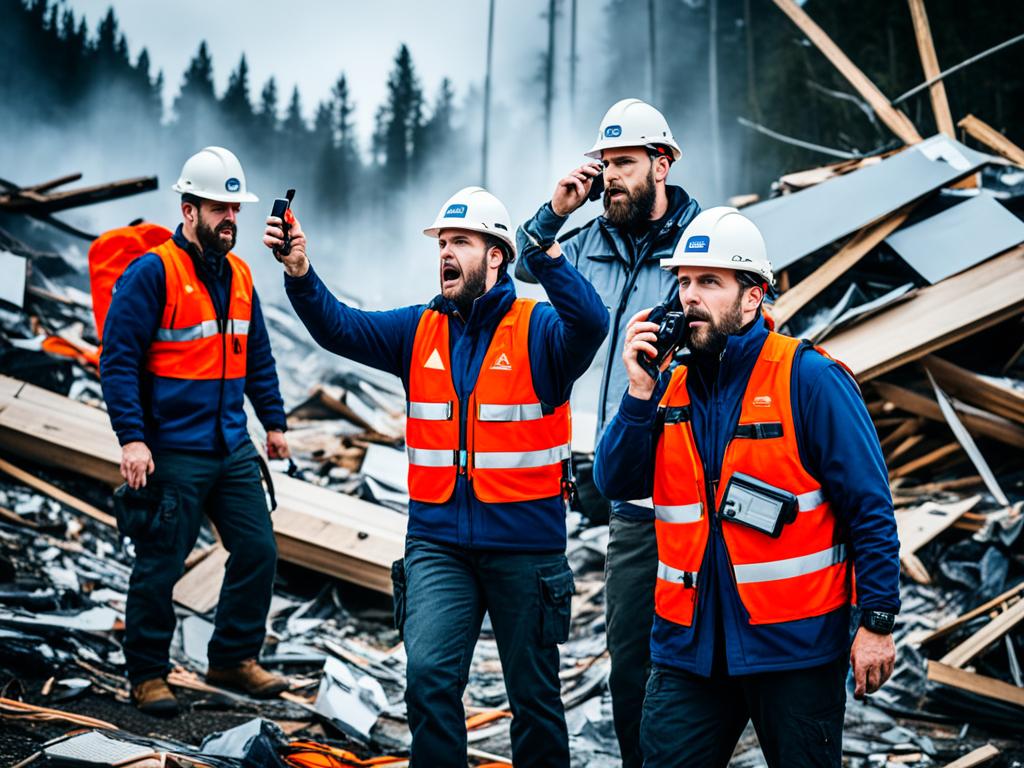When disaster hits, clear steps make a big difference between chaos and order. I know how crucial emergency communication plans for disaster scenarios are. Whether facing natural disasters or human-made crises, a detailed disaster recovery communication plan provides hope and direction. It’s essential to know and use the best communication systems for disaster management. It’s not only about following steps; it’s about staying alive.
In a crisis, there’s no time for confusion. That’s why it’s important to have a plan ready ahead of time. Let me show you the key ideas that work in emergencies. These strategies have been proven to save lives, keep order, and help recovery in the toughest times.
Key Takeaways
- Recognizing the integral role of an emergency communication plan in disaster scenarios.
- Understanding how a solid communication framework supports every phase of disaster management.
- The critical importance of clear, concise messaging during emergencies.
- Insights into the suitability and effectiveness of various communication systems amid disaster conditions.
- Practical advice on designing an emergency communication plan tailored to specific needs and circumstances.
Understanding the Importance of a Solid Emergency Communication Plan
When disaster hits, everything turns chaotic. Only a strong communication plan can guide us through the mess. A successful emergency response needs a solid emergency preparedness communication strategy. This includes planning, setting up rules, and using emergency notification systems for disasters. It makes sure everyone involved can react quickly and clearly.
Exploring disaster management showed me something important. Communication isn’t just about sharing information. It’s the thread that keeps emergency responses together.
Why Communication is Critical in Disaster Scenarios
We learn from real disasters that quick and accurate communication is crucial. Stories of natural and human-made emergencies teach us. A smooth relief effort starts with strong crisis communication strategies for emergencies. This includes organizing rescue teams, sending warnings, or managing resources. Each step needs clear communication.
The Impact of Clear Communication on Emergency Response Success
A clear message can make a big difference in a crisis. It can speed up responses, prevent harm, and save lives. Good crisis communication strategies for emergencies mixed with easy-to-use emergency notification systems for disasters improve response times. This makes emergency responses more effective overall.
During my career, I’ve seen what works and what doesn’t in emergency management. It’s clear that having a strong emergency preparedness communication strategy is essential. It’s not just a good idea—it’s necessary for being ready and resilient against unexpected disasters.
Designing Your Emergency Preparedness Communication Strategy
When disaster hits, it’s crucial to have a clear crisis communication plan for emergencies. You need to be ready before it’s necessary. Planning ahead helps you manage crises effectively. I’ll share my approach to building a plan suited to my needs.

Start by understanding your community or organization’s specifics. Assess the risks, resources, and key people involved. Knowing these helps shape the foundation of your communication strategy during emergencies.
Effective disaster response communication needs to be clear, timely, and reach everyone concerned. It must focus on safety and adjust to emergencies as they unfold.
- Identify key stakeholders: Find out who must be kept informed during a crisis, both within and outside your organization.
- Designate communication roles: Assign roles like media liaison, internal communication coordinator, and emergency services contact to specific individuals.
- Create messaging templates: Have messages ready for different situations to speed up communication when it counts.
- Establish notification systems: Use effective channels to share information quickly and reliably.
- Test the plan: Practicing reveals weaknesses and offers chances to make your emergency communication better.
An emergency preparedness communication strategy must also outline how to keep everyone updated. Being open and honest is key to keeping trust during a crisis.
| Component | Description | Relevance |
|---|---|---|
| Assessment | Evaluate the specific risks and resources. | Makes sure the plan fits your actual needs and abilities. |
| Stakeholder Mapping | Figure out who needs information. | Ensures nobody is left out. |
| Role Assignments | Give out communication tasks. | Helps avoid confusion by making duties clear. |
| Template Creation | Ready messages for different crisis scenarios. | Makes communication quicker during an emergency. |
| Notification Channels | Pick how to send messages. | Ensures messages get to the right people fast. |
The secret to a great crisis communication plan for emergencies is constant improvement. Learn from each exercise, listen to feedback, and be willing to change. This approach keeps your disaster response strong.
Key Elements of Disaster Response Communication Protocol
When disaster strikes, the success hinges on effective emergency communication procedures. It’s not just about sending a message. It’s crucial that the message sparks the correct action timely, blending technology with human understanding. Let’s examine the essential elements of this protocol.
Quick alerts through emergency notification systems for disasters can save lives and reduce damage. Working with local authorities and having a dependable system are important. But, what makes these systems work well? Let’s look into the key factors.
- Establishing Clear Communication Channels: Setting up primary and secondary paths ensures messages get through, even if some systems fail.
- Defining Roles and Responsibilities: Clearly stating who does what within the team helps make decisions and avoids confusion.
- Disseminating Information: Sharing updates with the public, press, and stakeholders quickly and accurately.
| Element | Description | Importance |
|---|---|---|
| Communication Plan Documentation | A detailed written protocol for emergency communication steps and procedures. | It ensures consistency and serves as a guide for training and real events. |
| Technology Integration | Employing specific software and hardware solutions designed for emergencies. | This increases the system’s reliability against failures and supports multiple communication methods. |
| Training & Drills | Conducting regular practices to mimic disaster situations and evaluate the communication process. | It readies the team for actual incidents and identifies improvement opportunities. |
In emergencies, having effective emergency communication procedures is critical. By combining modern emergency notification systems for disasters, response teams can act swiftly and thoughtfully. This readiness ensures swift action and brings calm during crises.
Developing a Crisis Communication Plan for Emergencies
Creating a good crisis communication plan takes a lot of steps. It needs you to think about many things. I’ll help you learn how to make your group ready to face surprises.

Identifying Stakeholders and Channels
First, figure out who your stakeholders are. These are the people or groups interested in how your organization handles a crisis. This could be your workers, customers, suppliers, or even the news people. After spotting them, choose the best ways to talk to them. Pick channels that are already part of your plan for managing disasters. This ensures quick and clear messages during tough times.
Creating a Communication Hierarchy and Roles
Then, setting up a clear communication order is key. It helps share information well during emergencies. Knowing who does what stops mix-ups and helps everyone know their tasks. This setup is crucial for your disaster management plan to work well.
With these steps, your emergency plan will be strong and ready to act. Remember to check and improve your plan often. This keeps it up to date with new threats and changes in tech or your group’s setup.
Choosing Reliable Communication Systems for Disaster Management
When disaster hits, strong communication tools are key. Through experiences, I’ve seen the need for solid communication systems for disaster management. These systems help us respond quickly and recover. Today, let’s talk about how to ensure we pick the right tech. We’ll also discuss the importance of a solid disaster recovery communication plan.
Evaluating Available Technologies
Looking at the tech we have, we must think about several things. These include how it works, how tough it is, if it can work with other systems, is it easy to use, and can we make it bigger if needed. From satellite phones to advanced radios, we have many options. Each one must be checked to make sure it fits our emergency plans.
Redundancy and Backup Options
In my experience, having backup communication systems for disaster management is crucial. It’s not enough to have just a Plan B. We need Plans C and D too. Having extras like portable internet, emergency alerts, and backup power helps avoid communication fails. So, our disaster recovery communication plan stays up and running, keeping everything coordinated.
Picking the right tech and having backups make a disaster management plan strong. This protects our communities and makes disaster response and recovery better.
Emergency Communication Procedures: A Step-by-Step Guide
When disaster hits, a well-thought-out emergency communication procedures plan makes a big difference. It changes chaos into coordination. Creating an emergency preparedness communication strategy is smart and necessary. I have created a guide to help you set up and use effective communication in emergencies.
The first steps to building your plan include:
- Figuring out your needs and the disasters that might affect your area.
- Collecting contact info for important people and stakeholders.
- Defining clear communication roles and responsibilities.
Next, we talk about putting things on paper:
- Create a detailed action plan for different emergency situations.
- Make sure all plan details are written clearly and easy to find for everyone involved.
- Keep the plan updated with any changes in people or steps.
Now, let’s focus on making the plan work:
- Educate your team about the emergency communication steps.
- Have regular drills to make sure everyone knows what to do.
- Set up a way to get feedback to improve the communication plan.
Don’t forget about having a backup for your emergency preparedness communication strategy:
- Have extra systems ready so you can still communicate if the main ones go down.
- Look into different technologies for reliable backup communication methods.
- Keep a list of second choices for all key roles in case someone can’t do their job.
Success with emergency communication procedures isn’t just about making a plan. It’s about practicing, using, and improving it. Always be on the lookout to make your strategies better with new practices and tech.
Writing and Testing Your Disaster Recovery Communication Plan
Making a solid disaster recovery communication plan involves more than just writing down steps. It requires a practical method with tests through drills and simulations. Practicing real-life scenarios helps show both the strong points and weak spots in our crisis plans. The goal is to face the unexpected, check our communication systems, and make sure everyone knows their role in a crisis.
Drills and Simulations: Training for Real-World Scenarios
Think about handling an actual emergency: it’s abrupt and tense. That’s why drills and simulations are key for realistic training. They get us used to different types of crises and reinforce the crisis communication plan for emergencies. These practices check how ready and flexible we are, and how quickly we can act. With the right communication tools, we refine our strategies.
Gathering Feedback and Improving Procedures
Post-drill, I always meet with my team to discuss their thoughts. We talk about what went well, what didn’t, and why. Their feedback is crucial as it’s based on experiences close to actual emergencies. Through accepting and applying this feedback, we enhance our disaster recovery communication plan, turning ideas into effective actions.
Effective communication can be the difference between chaos and control during a disaster.
Focused development and testing of a disaster recovery plan goes beyond protocol. It’s about building a culture of readiness that greatly lessens risks during actual emergencies.
Emergency Notification Systems for Disasters: What You Need to Know
It’s crucial to know about emergency notification systems for disasters. These systems help send out urgent messages quickly. This guide will help you understand these systems better, so you can pick the right one.
These systems can contact lots of people quickly through various ways like sirens, texts, emails, and social media. They’re used when disasters happen or there’s a safety threat. With them, people can get warnings and know what to do to stay safe.
| Type of System | Primary Uses | Benefits | Limitations |
|---|---|---|---|
| Mass Text Messaging | Evacuation orders, severe weather alerts | Immediate dissemination, high reach | Dependence on cellular network availability |
| Email Alerts | Informative updates, recovery resources | Detailed information capacity | Potential delays, not suitable for urgent alerts |
| Social Media Updates | Real-time engagement, rumor control | Widespread and rapid sharing | Requires internet access, potential misinformation |
| Sirens and Public Address Systems | Immediate local warnings | Effective for those outdoors or in public spaces | Limited range, not always clear instructions |
| Emergency Alert System (EAS) | National security threats, local emergencies | Integrates multiple broadcasting platforms | May not target all devices automatically |
Choosing a good system means it should work even during power cuts or when the network is busy. A great emergency notification system for disasters reaches everyone, no matter the challenges.
Plan your crisis communication strategies for emergencies well. This way, you’ll be ready to share important info when needed. So, don’t wait for a crisis to find weak spots. Check these systems now and prepare ahead.
Incorporating Technology: Modern Solutions for Crisis Communication
In the digital age, tech plays a big role in crisis communication. Advanced emergency plans now use modern tools. These tools have changed how we talk during a crisis.
Exploring Apps and Software
Crisis management apps and software are now key for a smooth response. They share info in real-time. This keeps first responders and the public up-to-date.
There are apps for sending alerts and software for managing resources. Technology helps protect lives and infrastructure during emergencies.
Modern emergency communication apps not only facilitate rapid information dissemination but also aid in the coordination of volunteer efforts, allocation of aid, and tracking the progress of recovery operations.
Utilizing Social Media During Disasters
Social media is vital for emergency communication. It’s useful when other channels might not work. It allows fast and efficient info sharing.
- It’s a platform for official sources to broadcast vital alerts and updates.
- Social media enables the community to share real-time developments.
- Hashtags can aggregate vital information for easier access during crises.
Using social media wisely is important in emergencies. It’s great for spreading info, but can also spread false news. So, it’s important to check facts and sources.
| App/Software | Features | Use Case |
|---|---|---|
| Red Cross Emergency App | Alerts, shelter locations, emergency advice | General Public |
| FEMA App | Disaster resources, weather warnings, tips | National Response Coordination |
| Nextdoor | Neighborhood-specific information sharing | Community Level |
| Zello | Walkie-talkie communication functionality | On-the-ground Volunteers |
Using advanced tech in crisis situations improves our readiness. It also makes communities stronger in facing disasters. Evolving our emergency plans with these tools is key for the future.
Conclusion
Throughout our journey, we’ve looked at how crucial emergency communication plans are. We’ve seen their key role for anyone or any group. Disasters are unpredictable and serious. This makes having an emergency plan more than a precaution—it’s essential.
We’ve talked about what makes a strong communication plan. We pointed out that being clear, efficient, and ready boosts our ability to face challenges. Every step, from planning to using new tech, helps protect us from chaos.
As we wrap up, remember that building a good emergency plan is a continuous process. It’s about staying safe and prepared. I encourage you to use the insights from this discussion. Let your emergency plan be a light guiding you through dark, unexpected times.

